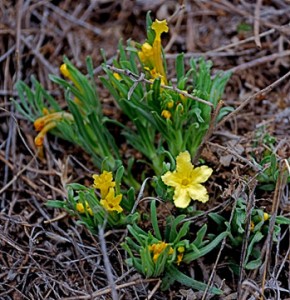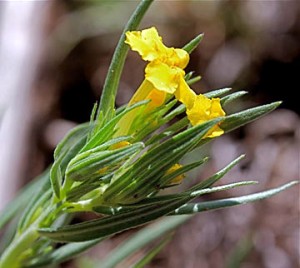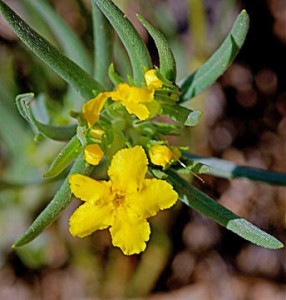Scientific Name: Lithospermum incisum
Plant Family: Boraginaceae – Borage, Forget-me-not
Common Name: Puccoon, Fringed gromwell, Narrowleaf stoneseed
By Janice Tucker

Flower of Puccoon (photo: Janice Tucker)
Spring often seems to come slowly to Santa Fe. The first bulbs tease us with their bright flowers but soon disappear to leave us for what seems to be weeks before seeing another blooming plant. Thankfully, in early spring the sassy little Puccoon flirtatiously shows its bright, yellow, ruffled flowers in peek-a-boo fashion from beneath the lower branch of a larger plant. But unlike the spring bulbs, the Puccoon will not soon forsake us and will continue to bloom throughout the summer.
Usually found in semi-desert environments, the Puccoon is native to much of the United States and Central Canada. This hairy, deciduous perennial has a substantial taproot and woody caudex (a thickened, short perennial underground or near ground level stem) that produces multiple stems lined with alternate, elongated, pointed, 2½ inch leaves. In early spring as the Puccoon’s stems and leaves push through the earth, its bright yellow or gold, trumpet shaped, fringed, five-petaled flowers begin to bloom atop the stems and the plant continues to flower as it increases in size. The growth habit is usually low to the ground and often found tucked just beneath the outer reaches of a larger shrub-like plant such as Chamisa. But, it can stand alone, growing as tall as 20 inches, especially when in a location that receives a regular supply of moisture. Its showy flowers produce very few seeds. As the plant matures, small, almost invisible but very fertile flowers are formed. These flowers do not open but will produce four oblong nutlets in the lower leaf axils. Each nutlet encases a hard, white seed.

Puccoon side view (photo: Janice Tucker)
Home gardeners who wish to propagate the Puccoon by seed should collect them from the nutlets in late summer. Instead of cold stratifying that is often necessary for many wildflower seeds, the Puccoon seeds should be soaked overnight in hot water and planted immediately. However, seed germination is sporadic and often disappointing. A more successful method may be to take 2-inch root cuttings in the fall. Dip the cuttings in a root stimulant and plant in a desirable location. The Puccoon requires very little water, full sun, and sandy, clay or loamy soil. It is a good plant for xeric gardens or included with other plants to establish a wildflower meadow.
The genus, Lithospermum, is a combined word from the Greek lithos (stone) and sperma (seed), referring to the stone hard seeds. Incisum (deeply cut) describes the fringed edges of the petals. Puccoon evolved from poughkone, a word the Virginia Algonquian language used for plants whose roots yield a red or yellow pigment. These plant roots were historically used as dyes ranging from purple to red to yellow. The Puccoon does have medicinal properties, but contains potentially toxic alkaloids. Self-treatment involving this plant is strongly discouraged.

Puccoon flower (photo: Janice Tucker)
The bright yellow Puccoon is not what usually comes to mind when thinking of Forget-me-nots. It is the pretty, blue flowers of the Myosotis genus that are better known by that common name. Yet, both are in the Forget-me-not (Boraginaceae) plant family.
The Puccoon grows on the north and south dry upland areas at Santa Fe Botanical Garden’s Leonora Curtin Wetland Preserve. In April and early May we “forget not” the Puccoon as we embark on our annual search for its pretty, fringed, yellow flowers.
Read more about Puccoon in our Plant Database.


